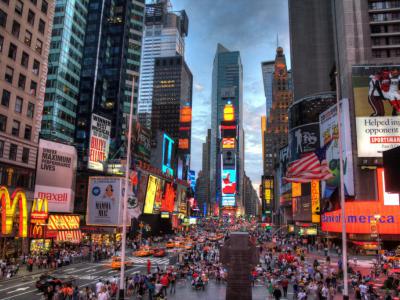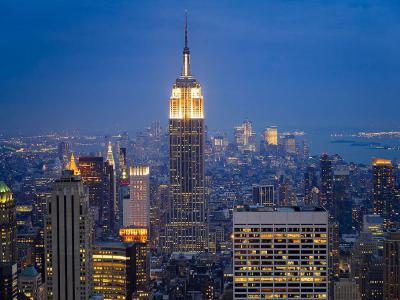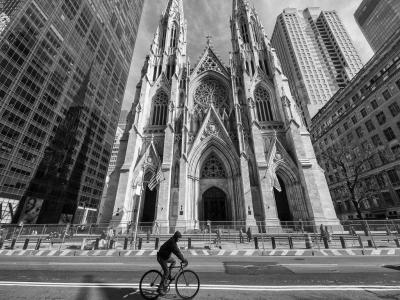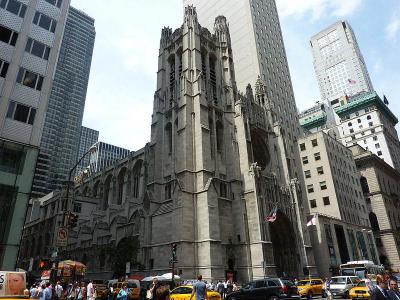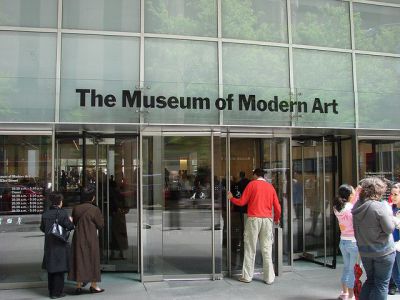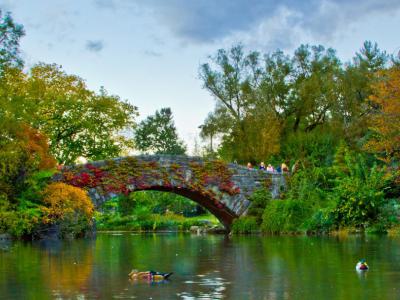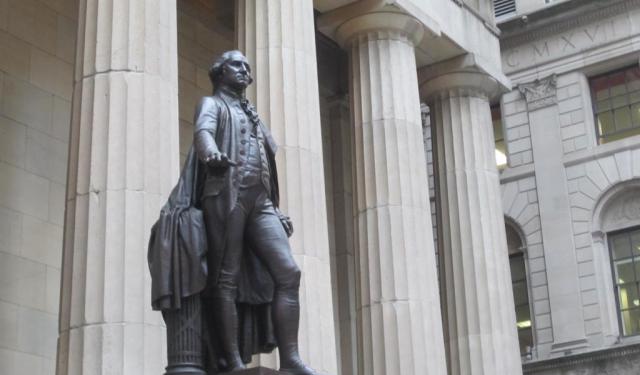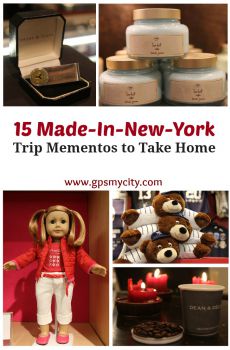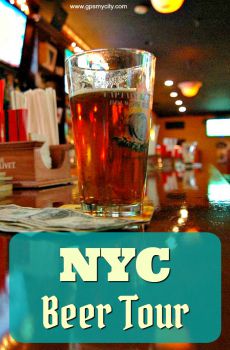Times Square to Central Park (Self Guided), New York
A leisurely self-guided stroll from Times Square to Central Park will take you to some of NYC’s prominent locations, each worth visiting in their own right.
At 49th Street, Fifth Avenue lives up to its lofty reputation with the Rockefeller Center, one of the world’s biggest business and entertainment complexes, and a triumph of Art Deco architecture. Like the neighboring Times Square, the adjoining plaza is one of the must-visit spots on the journey, but slightly less crowded and particularly awesome during the winter (Nov–Jan), when the skating rink and Christmas tree are set up for the holidays. A great place for photo ops in other seasons, too!
Next on the way are two Gothic masterpieces which stand almost opposite each other – St. Patrick's Cathedral and St. Thomas' Episcopal Church, followed by the Museum of Modern Art (MoMA), which houses almost 200,000 artworks ranging from Post-Impressionist classics to an unrivaled collection of modern & contemporary art. A large expansion and comprehensive renovation has made the famous museum a gigantic affair where you can explore each floor as a coherent loop before heading on to other floors via central staircases or elevators.
After a while inside the MoMA, proceed to the Gapstow Bridge toward the Central Park’s main promenade – the Mall, where artists and vendors gather. When you reach the end of it, walk around the Bethesda Terrace whose grand fountain dates as far back as 1859. Whether you’re visiting Central Park for the first time or the umpteenth-time, this classy place with superb views should always be a must-stop!
Take this self-guided walk to soak in Midtown Manhattan’s architecture, ending with the many hidden gems of Central Park at your fingertips!
At 49th Street, Fifth Avenue lives up to its lofty reputation with the Rockefeller Center, one of the world’s biggest business and entertainment complexes, and a triumph of Art Deco architecture. Like the neighboring Times Square, the adjoining plaza is one of the must-visit spots on the journey, but slightly less crowded and particularly awesome during the winter (Nov–Jan), when the skating rink and Christmas tree are set up for the holidays. A great place for photo ops in other seasons, too!
Next on the way are two Gothic masterpieces which stand almost opposite each other – St. Patrick's Cathedral and St. Thomas' Episcopal Church, followed by the Museum of Modern Art (MoMA), which houses almost 200,000 artworks ranging from Post-Impressionist classics to an unrivaled collection of modern & contemporary art. A large expansion and comprehensive renovation has made the famous museum a gigantic affair where you can explore each floor as a coherent loop before heading on to other floors via central staircases or elevators.
After a while inside the MoMA, proceed to the Gapstow Bridge toward the Central Park’s main promenade – the Mall, where artists and vendors gather. When you reach the end of it, walk around the Bethesda Terrace whose grand fountain dates as far back as 1859. Whether you’re visiting Central Park for the first time or the umpteenth-time, this classy place with superb views should always be a must-stop!
Take this self-guided walk to soak in Midtown Manhattan’s architecture, ending with the many hidden gems of Central Park at your fingertips!
How it works: Download the app "GPSmyCity: Walks in 1K+ Cities" from Apple App Store or Google Play Store to your mobile phone or tablet. The app turns your mobile device into a personal tour guide and its built-in GPS navigation functions guide you from one tour stop to next. The app works offline, so no data plan is needed when traveling abroad.
Times Square to Central Park Map
Guide Name: Times Square to Central Park
Guide Location: USA » New York (See other walking tours in New York)
Guide Type: Self-guided Walking Tour (Sightseeing)
# of Attractions: 7
Tour Duration: 2 Hour(s)
Travel Distance: 3.2 Km or 2 Miles
Author: gabriela
Sight(s) Featured in This Guide:
Guide Location: USA » New York (See other walking tours in New York)
Guide Type: Self-guided Walking Tour (Sightseeing)
# of Attractions: 7
Tour Duration: 2 Hour(s)
Travel Distance: 3.2 Km or 2 Miles
Author: gabriela
Sight(s) Featured in This Guide:
- Times Square
- Rockefeller Center
- St. Patrick's Cathedral
- Saint Thomas Church
- Museum of Modern Art (MoMA)
- Gapstow Bridge and The Pond
- Bethesda Terrace
1) Times Square (must see)
Long before Manhattan’s tidy street plan straightened everything out, Broadway, unlike other streets in New York, followed an older native pathway, wandering freely up the island. This is why it slices across Seventh Avenue and 42nd Street, forming two triangular pockets, like a bow tie. The southern one is called Times Square, while the northern, Duffy Square, is named for World War I chaplain Father Francis P. Duffy, whose statue now watches over the crowds with admirable patience.
The stretch of Broadway from 41st to 53rd Streets goes by a different name: the Great White Way. That nickname wasn’t poetic exaggeration—those glowing billboards, marquees, and oversized posters once made the area one of the brightest electrified spots on Earth. Today, it’s still blazing away with advertisements for Broadway’s latest musicals and plays, pulling in nearly 50 million visitors a year. That’s roughly 330,000 people a day, all weaving through the lights, noise, and spectacle in search of something unforgettable.
Before it was Times Square, this chaotic crossroads answered to the far calmer name of Longacre Square. Everything changed in 1904, when New York Times publisher Adolph S. Ochs moved his newspaper into the brand-new Times Building—now known as One Times Square—and happily lent his name to the neighborhood. The Times moved out within a decade, but not before launching a little tradition in 1907: the New Year’s Eve Ball Drop. A century later, the glittering descent still draws over a million people every year, along with countless viewers around the world.
Today, Times Square is a fluorescent buffet of attractions—ABC’s Times Square Studios, Planet Hollywood, Bubba Gump Shrimp Company, and whichever character impersonator is bravest that day. The towering illuminated signs, nicknamed “spectaculars” or “jumbotrons,” compete with the neon bravado of Las Vegas and often win.
Amid all that glow, shoppers duck into stores like Gap, Old Navy, Forever 21, Levi’s, the Disney Store, Hershey’s Chocolate World, and M&M’s World—each one flashing its own brand of temptation. Whether you’re hunting for a souvenir, a show, or just a moment to stand still and stare, this Midtown crossroads remains New York at its most unfiltered and unmistakable.
The stretch of Broadway from 41st to 53rd Streets goes by a different name: the Great White Way. That nickname wasn’t poetic exaggeration—those glowing billboards, marquees, and oversized posters once made the area one of the brightest electrified spots on Earth. Today, it’s still blazing away with advertisements for Broadway’s latest musicals and plays, pulling in nearly 50 million visitors a year. That’s roughly 330,000 people a day, all weaving through the lights, noise, and spectacle in search of something unforgettable.
Before it was Times Square, this chaotic crossroads answered to the far calmer name of Longacre Square. Everything changed in 1904, when New York Times publisher Adolph S. Ochs moved his newspaper into the brand-new Times Building—now known as One Times Square—and happily lent his name to the neighborhood. The Times moved out within a decade, but not before launching a little tradition in 1907: the New Year’s Eve Ball Drop. A century later, the glittering descent still draws over a million people every year, along with countless viewers around the world.
Today, Times Square is a fluorescent buffet of attractions—ABC’s Times Square Studios, Planet Hollywood, Bubba Gump Shrimp Company, and whichever character impersonator is bravest that day. The towering illuminated signs, nicknamed “spectaculars” or “jumbotrons,” compete with the neon bravado of Las Vegas and often win.
Amid all that glow, shoppers duck into stores like Gap, Old Navy, Forever 21, Levi’s, the Disney Store, Hershey’s Chocolate World, and M&M’s World—each one flashing its own brand of temptation. Whether you’re hunting for a souvenir, a show, or just a moment to stand still and stare, this Midtown crossroads remains New York at its most unfiltered and unmistakable.
2) Rockefeller Center (must see)
Back in 1801, a New York physician named David Hosack bought 22 acres of empty land from the city with an aim to establish America’s first botanical garden. And for the next ten years, the Elgin Botanic Garden really did bloom—until funding wilted, the plants went wild, and Columbia University had to step in to take over the property in 1823.
Fast-forward a century to 1926, when the Metropolitan Opera went searching for a grand new home. Columbia leased the land to its generous patron, John D. Rockefeller, Jr., setting the stage for a glittering cultural palace. Then the stock market crashed in 1929, the opera backed out, and Rockefeller found himself with prime New York real estate and no tenant. So, he pivoted—and decided to build a mass-media powerhouse instead.
In 1930, after months of negotiations involving Radio Corporation of America, National Broadcasting Company, and Radio-Keith-Orpheum, the plan was set: an entertainment complex of unprecedented scale. To make room, 228 buildings were cleared and 4,000 tenants relocated. Early name ideas included “Radio City,” “Rockefeller City,” and the dramatic “Metropolitan Square,” before the now-famous title finally stuck.
Today, Rockefeller Center stretches across all of Doctor Hosack’s original 22 acres—though the botanicals have long been replaced with 14 Art Deco buildings, a standalone tower along 51st Street, and four more rising on the west side of Sixth Avenue. There are rooftop gardens, but you’ll have to crane your neck to see anything green.
On the west side sits Radio City Music Hall, still flashing its neon glamour. And at the heart of it all lies the sunken Lower Plaza, praised by Chinese-American architect Ieoh Ming Pei as “the most successful open space in the United States, perhaps in the world.” Most visitors simply know it as “the place with the ice rink,” which has been delighting skaters since 1936.
Then there’s the view. “Top of the Rock” offers three levels of indoor and outdoor decks with clear, cinematic vistas of the New York skyline. Back on the ground, the shops spread out in every direction—big names, small designers, and everything in between. It’s the kind of place where you realize: shopping isn’t just about what you buy; it’s about where you buy it...
Fast-forward a century to 1926, when the Metropolitan Opera went searching for a grand new home. Columbia leased the land to its generous patron, John D. Rockefeller, Jr., setting the stage for a glittering cultural palace. Then the stock market crashed in 1929, the opera backed out, and Rockefeller found himself with prime New York real estate and no tenant. So, he pivoted—and decided to build a mass-media powerhouse instead.
In 1930, after months of negotiations involving Radio Corporation of America, National Broadcasting Company, and Radio-Keith-Orpheum, the plan was set: an entertainment complex of unprecedented scale. To make room, 228 buildings were cleared and 4,000 tenants relocated. Early name ideas included “Radio City,” “Rockefeller City,” and the dramatic “Metropolitan Square,” before the now-famous title finally stuck.
Today, Rockefeller Center stretches across all of Doctor Hosack’s original 22 acres—though the botanicals have long been replaced with 14 Art Deco buildings, a standalone tower along 51st Street, and four more rising on the west side of Sixth Avenue. There are rooftop gardens, but you’ll have to crane your neck to see anything green.
On the west side sits Radio City Music Hall, still flashing its neon glamour. And at the heart of it all lies the sunken Lower Plaza, praised by Chinese-American architect Ieoh Ming Pei as “the most successful open space in the United States, perhaps in the world.” Most visitors simply know it as “the place with the ice rink,” which has been delighting skaters since 1936.
Then there’s the view. “Top of the Rock” offers three levels of indoor and outdoor decks with clear, cinematic vistas of the New York skyline. Back on the ground, the shops spread out in every direction—big names, small designers, and everything in between. It’s the kind of place where you realize: shopping isn’t just about what you buy; it’s about where you buy it...
3) St. Patrick's Cathedral (must see)
In case you wonder why New York has two Saint Patrick’s Cathedrals, it’s not because the city has twice as many saints—it’s because the first one simply couldn’t keep up. The Old Cathedral from 1815 did its best, but by the mid-1800s, the Archdiocese had outgrown it. So, in 1858, construction began on a new spiritual heavyweight: the towering Gothic Revival cathedral that now occupies the block between 50th and 51st Streets on Madison Avenue. Designed by James Renwick Jr. and formally opened in 1879, it rises directly across from Rockefeller Center, as if keeping an eye on the skating rink...
From the outside, the building is a full Gothic drama. Marble everywhere, pointed arches stacked like architectural exclamation marks, and stained-glass windows glowing in neat vertical ranks. The whole structure stretches 332 feet in length, with transepts spanning 174 feet. But the true attention-grabbers are the twin spires—330 feet of pure, sky-seeking ambition—framing the bronze entrance doors.
Step inside, and the scale refuses to let up. A broad central aisle is flanked by two narrower ones, separated by 32 marble columns that seem determined to out-pose each other. Look up, and you’ll see ribbed Gothic vaults meeting in elegant bosses overhead. Along the sides, twelve chapels create quieter pockets of devotion, while seating for 2,400 fills the nave with long lines of wooden pews.
Even the high altar has a story. The original version was shipped off to Fordham University Church in the Bronx, making room for the current altar carved from grey-white Italian marble and crowned by a bronze baldachin. It rises beneath a statue of Christ the King, complete with angels and decorative pinnacles.
Today, the “new” Saint Patrick’s Cathedral is firmly established as one of Manhattan’s defining landmarks, recognized both as a New York City designated landmark and listed on the National Register of Historic Places—a cathedral built to impress, and one that still succeeds brilliantly!
From the outside, the building is a full Gothic drama. Marble everywhere, pointed arches stacked like architectural exclamation marks, and stained-glass windows glowing in neat vertical ranks. The whole structure stretches 332 feet in length, with transepts spanning 174 feet. But the true attention-grabbers are the twin spires—330 feet of pure, sky-seeking ambition—framing the bronze entrance doors.
Step inside, and the scale refuses to let up. A broad central aisle is flanked by two narrower ones, separated by 32 marble columns that seem determined to out-pose each other. Look up, and you’ll see ribbed Gothic vaults meeting in elegant bosses overhead. Along the sides, twelve chapels create quieter pockets of devotion, while seating for 2,400 fills the nave with long lines of wooden pews.
Even the high altar has a story. The original version was shipped off to Fordham University Church in the Bronx, making room for the current altar carved from grey-white Italian marble and crowned by a bronze baldachin. It rises beneath a statue of Christ the King, complete with angels and decorative pinnacles.
Today, the “new” Saint Patrick’s Cathedral is firmly established as one of Manhattan’s defining landmarks, recognized both as a New York City designated landmark and listed on the National Register of Historic Places—a cathedral built to impress, and one that still succeeds brilliantly!
4) Saint Thomas Church
The Saint Thomas Church is an Episcopal parish church located in the heart of New York City. It is one of the few churches where the old Anglican choral tradition is still preserved.
Previously, the congregation of Saint Thomas's worshiped in three other locations before the present one was built. Designed by architects Ralph Adams Cram and Bertram Grosvenor Goodhue in High Gothic style, featuring plain limestone exterior and sandstone interior, the current church was built between 1911 and 1916 looking absolutely fantastic among the towering skyscrapers. The intricate stonework on the reredos – white carved screens behind the altar and interesting carvings on the choir stalls showing “modern” inventions like the radio and telephone – was done be sculptor Lee Laurie, while the fine stained glass windows were created by English artist, James Hunphries Hogan, of Powell and Sons (Whitefriars) Ltd. of London.
Music is an important part of worship and liturgy at Saint Thomas's, in large part thanks to the design offering excellent acoustics, as well as the three old and one new incredible Dobson pipe organ (worth $11 million) added in 2008. There are free organ recitals most Sundays, the sound of which is profoundly moving. The church's choir performs traditional Anglican Evensong, a 45 minute service of music by young boys aged between 8 and 13. This choir is supported by the Saint Thomas choir school that was founded by the parish in 1919 and is one of four remaining choir schools in the world.
While everyone goes to check out Saint Patrick's, and quite rightly so, you still might be cheating yourself if you don’t visit Saint Thomas's, which is just a few blocks away. Its beautiful altar area, stained glass and ceiling are absolutely worth a look, and will leave you in awe. Highly recommended!
Previously, the congregation of Saint Thomas's worshiped in three other locations before the present one was built. Designed by architects Ralph Adams Cram and Bertram Grosvenor Goodhue in High Gothic style, featuring plain limestone exterior and sandstone interior, the current church was built between 1911 and 1916 looking absolutely fantastic among the towering skyscrapers. The intricate stonework on the reredos – white carved screens behind the altar and interesting carvings on the choir stalls showing “modern” inventions like the radio and telephone – was done be sculptor Lee Laurie, while the fine stained glass windows were created by English artist, James Hunphries Hogan, of Powell and Sons (Whitefriars) Ltd. of London.
Music is an important part of worship and liturgy at Saint Thomas's, in large part thanks to the design offering excellent acoustics, as well as the three old and one new incredible Dobson pipe organ (worth $11 million) added in 2008. There are free organ recitals most Sundays, the sound of which is profoundly moving. The church's choir performs traditional Anglican Evensong, a 45 minute service of music by young boys aged between 8 and 13. This choir is supported by the Saint Thomas choir school that was founded by the parish in 1919 and is one of four remaining choir schools in the world.
While everyone goes to check out Saint Patrick's, and quite rightly so, you still might be cheating yourself if you don’t visit Saint Thomas's, which is just a few blocks away. Its beautiful altar area, stained glass and ceiling are absolutely worth a look, and will leave you in awe. Highly recommended!
Sight description based on Wikipedia.
5) Museum of Modern Art (MoMA)
November 1929: the stock market has just fallen through the floor, and most of New York is clutching its wallet. Meanwhile, Abby Rockefeller and her two art-loving co-conspirators, Lillie Bliss and Mary Quinn Sullivan, take one look at the chaos and think, “Perfect time to open a museum...” And so, inside the Heckscher Building at 750 Fifth Avenue, the Museum of Modern Art (or MoMA, for short) threw open its doors—America’s first institution devoted entirely to Modern Art and European Modernism.
Bold? Absolutely. Sensible? Hmm, debatable. Visionary? Without question. Within a decade, the museum hopped addresses three times before finally settling down.
By 1939, MoMA staked its permanent home on 53rd Street between Fifth and Sixth Avenues, where it built its reputation as one of the most influential modern art museums on the planet. From the start, it championed the art of its time, collecting the bold, the experimental, and the occasionally eyebrow-raising.
Today, MoMA’s holdings stretch across architecture, design, painting, sculpture, prints, photography, film, and just about every creative medium you can plug in, flip through, or hang on a wall. Its library alone boasts more than 300,000 books, over 1,000 periodicals, and 40,000 pieces of ephemera—essentially everything artists have ever scribbled, mailed, stapled, or hastily tossed into history.
The museum organizes all this creative energy into six major departments: Architecture and Design, Drawings and Prints, Film, Media and Performance, Painting and Sculpture, and Photography. In total, MoMA oversees more than 150,000 works, 22,000 films, and pieces by more than 13,000 artists. And yes, the roster reads like the ultimate art-world roll call: Matisse, Picasso, Duchamp, Magritte, O’Keeffe, Hopper, Pollock, Warhol, Lichtenstein, and many more.
The building itself is a sleek modernist landmark. Step through the lobby, and you’ll spot the beloved Sculpture Garden—a serene pocket of trees, reflecting pools, and thought-provoking shapes. Above, staircases and elevators carry you into a maze of galleries. When you need a pause, there are cafés; when you want a film, there’s a theater rolling screenings most days.
MoMA is open daily, but here’s the city’s favorite pro tip: admission is free on Fridays after 5:30 p.m. To take advantage of it, just follow the crowds of excited New Yorkers who suddenly “remembered” they love modern art...
Bold? Absolutely. Sensible? Hmm, debatable. Visionary? Without question. Within a decade, the museum hopped addresses three times before finally settling down.
By 1939, MoMA staked its permanent home on 53rd Street between Fifth and Sixth Avenues, where it built its reputation as one of the most influential modern art museums on the planet. From the start, it championed the art of its time, collecting the bold, the experimental, and the occasionally eyebrow-raising.
Today, MoMA’s holdings stretch across architecture, design, painting, sculpture, prints, photography, film, and just about every creative medium you can plug in, flip through, or hang on a wall. Its library alone boasts more than 300,000 books, over 1,000 periodicals, and 40,000 pieces of ephemera—essentially everything artists have ever scribbled, mailed, stapled, or hastily tossed into history.
The museum organizes all this creative energy into six major departments: Architecture and Design, Drawings and Prints, Film, Media and Performance, Painting and Sculpture, and Photography. In total, MoMA oversees more than 150,000 works, 22,000 films, and pieces by more than 13,000 artists. And yes, the roster reads like the ultimate art-world roll call: Matisse, Picasso, Duchamp, Magritte, O’Keeffe, Hopper, Pollock, Warhol, Lichtenstein, and many more.
The building itself is a sleek modernist landmark. Step through the lobby, and you’ll spot the beloved Sculpture Garden—a serene pocket of trees, reflecting pools, and thought-provoking shapes. Above, staircases and elevators carry you into a maze of galleries. When you need a pause, there are cafés; when you want a film, there’s a theater rolling screenings most days.
MoMA is open daily, but here’s the city’s favorite pro tip: admission is free on Fridays after 5:30 p.m. To take advantage of it, just follow the crowds of excited New Yorkers who suddenly “remembered” they love modern art...
6) Gapstow Bridge and The Pond
One of the first landmarks to discover after entering Central Park's southeast corner, the robust Gapstow Bridge just so happens to be among the best spots for photography within the Park as well, along with Bethesda Fountain and the Belvedere Castle. Although not far off from several similar bridges, this one wins for the commanding and breathtaking views it offers, with natural scenery on one side and Manhattan's skyline on the other.
Originally wooden and cast-iron, though for the last hundred-plus years made of stone, the bridge itself may not be an architectural marvel but has a beautiful aesthetic presence to it. It's apparently also quite popular with locals, who come to watch the ducks in the pond and relax after work.
Originally wooden and cast-iron, though for the last hundred-plus years made of stone, the bridge itself may not be an architectural marvel but has a beautiful aesthetic presence to it. It's apparently also quite popular with locals, who come to watch the ducks in the pond and relax after work.
7) Bethesda Terrace
Featured in many Hollywood movies and TV shows, the Bethesda Terrace is one of the most easily recognizable landmarks of Central Park. It is a perfect place to unwind, watch street performers, enjoy music, or simply hang out and pass the time.
With its beautiful arcaded structure and carved limestone decorations, it stands as a fine example of 19th-century architecture, treating visitors to a lower and upper terrace surrounded by three staircases. This is all further highlighted by an attractive, large-scale fountain with the famous "Angel of the Water" statue on top and a beautifully tiled underpass, both of which are worth many pictures.
The "Angel of the Water" statue refers to "Healing the Paralytic", a story from the Gospel of John about an angel blessing the Pool of Bethesda, giving it healing powers.
In the end, it's a neat area to spend some time during visits to Central Park, particularly when the fountains are turned on and the trees in the area are in bloom or heavy with foliage. More often than not, you'll find people sitting on stone benches in the lower level to watch boats on the lake and get a glimpse of the high-rise buildings beyond.
With its beautiful arcaded structure and carved limestone decorations, it stands as a fine example of 19th-century architecture, treating visitors to a lower and upper terrace surrounded by three staircases. This is all further highlighted by an attractive, large-scale fountain with the famous "Angel of the Water" statue on top and a beautifully tiled underpass, both of which are worth many pictures.
The "Angel of the Water" statue refers to "Healing the Paralytic", a story from the Gospel of John about an angel blessing the Pool of Bethesda, giving it healing powers.
In the end, it's a neat area to spend some time during visits to Central Park, particularly when the fountains are turned on and the trees in the area are in bloom or heavy with foliage. More often than not, you'll find people sitting on stone benches in the lower level to watch boats on the lake and get a glimpse of the high-rise buildings beyond.
Walking Tours in New York, New York
Create Your Own Walk in New York
Creating your own self-guided walk in New York is easy and fun. Choose the city attractions that you want to see and a walk route map will be created just for you. You can even set your hotel as the start point of the walk.
New York's Central Park Walking Tour
Arguably the most famous public park in the world today, Central Park has been called the lungs of New York City – literally “central”, it is where Manhattanites go to get a sense of space and air. Plan for at least half a day to wander along its many pathways, take a rowboat on the water, enjoy the landscaping and the numerous man-made wonders, spend some time at the zoo or bring a pair of... view more
Tour Duration: 3 Hour(s)
Travel Distance: 4.6 Km or 2.9 Miles
Tour Duration: 3 Hour(s)
Travel Distance: 4.6 Km or 2.9 Miles
George Washington's New York
While not really a New York fan himself, George Washington held the city in high esteem, calling it “a post of infinite importance,” and is even credited with coining the term “New Yorker”. The scene of some of Washington’s greatest military trials and political triumphs, NYC is a home to several important sites associated with his life and career, such as Fraunces Tavern, Bowling Green,... view more
Tour Duration: 1 Hour(s)
Travel Distance: 1.6 Km or 1 Miles
Tour Duration: 1 Hour(s)
Travel Distance: 1.6 Km or 1 Miles
Brooklyn New York Walking Tour
The story of Brooklyn predates the brownstones and bagels. The area's earliest known inhabitants were the Lenape, the Indigenous tribe also known as the Delaware, who lived along the shores of the East River and Gowanus Bay long before Europeans discovered the uses of potatoes...
The Dutch, who arrived during the 17th century, established several farming villages here, naming one of them... view more
Tour Duration: 2 Hour(s)
Travel Distance: 3.9 Km or 2.4 Miles
The Dutch, who arrived during the 17th century, established several farming villages here, naming one of them... view more
Tour Duration: 2 Hour(s)
Travel Distance: 3.9 Km or 2.4 Miles
Midtown Manhattan Walking Tour
If you’ve ever pictured New York City as a canyon of skyscrapers, glowing billboards, and streets that pulse with constant activity, Midtown Manhattan is the version you likely imagined. Hard to believe, but this buzzing district started out as open farmland—proof that even the busiest corners of the world have humble beginnings... Everything changed after the Commissioners’ Plan of 1811... view more
Tour Duration: 2 Hour(s)
Travel Distance: 4.1 Km or 2.5 Miles
Tour Duration: 2 Hour(s)
Travel Distance: 4.1 Km or 2.5 Miles
Manhattan Architecture Walking Tour
The skyscraper, which has shaped Manhattan's distinctive skyline, has been closely associated with New York City’s identity since the end of the 19th century. Despite the Great Depression, some of the world’s tallest skyscrapers were completed in Manhattan during the 1930s, including numerous Art Deco masterpieces that are still part of the city's skyline – most notably the Empire... view more
Tour Duration: 2 Hour(s)
Travel Distance: 4.2 Km or 2.6 Miles
Tour Duration: 2 Hour(s)
Travel Distance: 4.2 Km or 2.6 Miles
Grand Central Station to Union Square
Despite being smaller than almost everything around it, including the humongous MetLife Building that dwarfs it from behind, the Grand Central Terminal is just so gorgeous and palatial-looking that it still manages to be the centerpiece of the whole East Side of Midtown Manhattan. Passing from here to Union Square, our self-guided tour is bound to introduce you to some of New York City’s most... view more
Tour Duration: 2 Hour(s)
Travel Distance: 3.8 Km or 2.4 Miles
Tour Duration: 2 Hour(s)
Travel Distance: 3.8 Km or 2.4 Miles
Useful Travel Guides for Planning Your Trip
NY Villages Best Tea and Coffee
This is a guide to the best tea and coffee shops and houses in the East, West, Washington Square and Greenwich Villages of Manhattan. None of these are chains, so tourists looking to avoid Starbucks can find sanctuary in this app. All of these run the gamut between W and E 14th Streets, and down 1st...
7 Best Drinking Places in Upper West Side, NY
With “Bar Tour of the Upper West Side” sample a cross section from NYC’s great gamut of drinking establishments, including a Belgian Brasserie, a wine bar, Irish pubs, and one dive — just for fun! These spots offer something a little extra, like craft beers, inspirational artwork, a chance...
NYC Souvenir Guide: 15 Authentic New York City Products to Take Home
In keeping with the song, one might think that, if they can make it in New York City, they can make it anywhere. Well, not always... Some of the things made in New York City aren't made anywhere else, and you'll definitely want to try or keep at least some of them to prolong your NYC...
Bar Tour of Lower East Side, New York City
The Lower East Side has been described the most livable neighborhood in NYC. Unique and dynamic, LES has boutique shops, cafes and restaurants alongside great bars and museums.In this historic neighborhood, residents strive to preserve its roots. Here, you can find young professionals who challenge...
NYC Beer Tour
There are many great places to drink in New York City. Still, discerning connoisseurs are likely to find themselves awash in a sea of mediocre beer without first gaining a proper lay of the beer land. For those whose curiosity and taste buds urge them to venture beyond ubiquitious draft staples like...
The Most Popular Cities
/ view all



